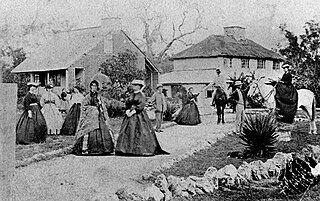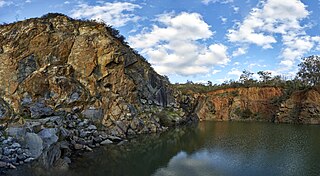
The Noongar are Aboriginal Australian people who live in the south-west corner of Western Australia, from Geraldton on the west coast to Esperance on the south coast. There are 14 different groups in the Noongar cultural bloc: Amangu, Ballardong, Yued, Kaneang, Koreng, Mineng, Njakinjaki, Njunga, Pibelmen, Pindjarup, Wadandi, Whadjuk, Wiilman and Wudjari. The Noongar people refer to their land as Noongar boodja.

Yagan was an Aboriginal Australian warrior from the Noongar people. Yagan was pursued by the local authorities after he killed Erin Entwhistle, a servant of farmer Archibald Butler. It was an act of retaliation after Thomas Smedley, another of Butler's servants, shot at a group of Noongar people stealing potatoes and fowls, killing one of them. The government offered a bounty for Yagan's capture, dead or alive, and a young settler, William Keats, shot and killed him. He is considered a legendary figure by the Noongar.

Toodyay, known as Newcastle between 1860 and 1910, is a town on the Avon River in the Wheatbelt region of Western Australia, 85 kilometres (53 mi) north-east of Perth. The first European settlement occurred in the area in 1836. After flooding in the 1850s, the townsite was moved to its current location in the 1860s. It is connected by railway and road to Perth. During the 1860s, it was home to bushranger Moondyne Joe.

Lieutenant-Colonel Frederick Chidley Irwin, KH was acting Governor of Western Australia from 1847 to 1848.
Robert Menli Lyon was a pioneering Western Australian settler who became one of the earliest outspoken advocates for Indigenous Australian rights and welfare in the colony. He published the first information on the Aboriginal language of the Perth area.

The Bussell family were a family of early settlers in colonial Western Australia. The four brothers John, Joseph Vernon, Alfred and Charles emigrated from England on Warrior, arriving at Fremantle on 12 March 1830. Lenox, Frances and Elizabeth arrived at Fremantle on Cygnet on 27 January 1833, and Mrs Frances Louisa and Mary arrived at Albany on 19 June 1834.

York is the oldest inland town in Western Australia, situated on the Avon River, 97 kilometres (60 mi) east of Perth in the Wheatbelt, on Ballardong Nyoongar land, and is the seat of the Shire of York.

Kelmscott is a southeastern suburb of Perth, Western Australian within the local government area of the City of Armadale. It is 23 kilometres (14 mi) southeast of Perth along the Albany Highway.
Midgegooroo was an Aboriginal Australian elder of the Nyungar nation, who played a key role in Aboriginal resistance to white settlement in the area of Perth, Western Australia. Everything documented about Midgegooroo is mediated through the eyes of the colonisers, some of whom, notably G.F. Moore, Robert Menli Lyon and Francis Armstrong, derived their information from discussions with contemporary Noongar people, in particular the son of Midgegooroo, Yagan. Largely due to his exploits in opposing colonisation and his relationship with Lyon and Moore, Yagan has a much sharper historical profile than his father. Midgegooroo was executed by firing squad and without trial under the authority of Lieutenant Governor Frederick Irwin in 1833.

The Wagyl is the Noongar manifestation of the Rainbow Serpent in Australian Aboriginal mythology, from the culture based around the south-west of Western Australia. The Noongar describe the Wagyl as a snakelike Dreaming creature responsible for the creation of the Swan and Canning rivers and other waterways and landforms around present day Perth and the south-west of Western Australia.

The Bindjareb, Binjareb, Pindjarup or Pinjareb are an Indigenous Noongar people that occupy part of the South West of Western Australia.

Whadjuk, alternatively Witjari, are Noongar people of the Western Australian region of the Perth bioregion of the Swan Coastal Plain.

The Pinjarra massacre, also known as the Battle of Pinjarra, occurred on 28 October 1834 in Pinjarra, Western Australia when a group of Binjareb Noongar people were attacked by a detachment of 25 soldiers, police, and settlers led by Governor James Stirling. According to Stirling, "about 60 or 70" of the Binjareb people were present at the camp and John Roe, who also participated, estimated about 70–80. This roughly agrees with an estimate of 70 by an unidentified eyewitness. The attack at Pinjarra was in response to sustained aggression by the Binjarebs, including robberies and murder of settlers and members of other Nyungar tribes.
Calyute, also known as Kalyute, Galyute or Wongir, was an Indigenous Australian resistance leader who was involved in a number of reprisal attacks with white settlers and members of other tribes in the early days of the Swan River Colony, in Western Australia. He was a member of the Pindjarup people from around the Murray River area south of Perth. Calyute's family included two brothers, Woodan and Yanmar, two wives, Mindup and Yamup, and two sons, Ninia and Monang.

The Murray River is a river in the southwest of Western Australia. It played a significant part in the expansion of settlement in the area south of Perth after the arrival of British settlers at the Swan River Colony in 1829. It should not be confused with the Murray River in southeastern Australia, which is the longest river in the country.
This is a timeline of Aboriginal history of Western Australia.

The Australian frontier wars were the violent conflicts between Indigenous Australians and primarily British settlers during the colonial period of Australia.
The Wonnerup massacre, also known as the Wonnerup "Minninup" massacre, was the killing of dozens of Wardandi Noongar people by European settlers in the vicinity of Wonnerup, Western Australia in February 1841. The massacre on Wardandi-Doonan land in the south-west of Western Australia took place after Gaywal/Gaywaar, a Wardandi Man, speared and killed George Layman, a settler at Wonnerup on 21 February 1841. The leaders of the punitive massacre were Layman's neighbours John Bussell and Captain John Molloy, resident magistrate of the district. Settlers from the Wonnerup, Capel, Busselton and Augusta area joined them to commit "one of the most bloodthirsty deeds ever committed by Englishmen".

Banyowla Regional Park, formerly Kelmscott-Martin Regional Park, is a conservation park in the Perth Hills, 20 kilometres south-east of Perth, Western Australia, located within the Cities of Gosnells and Armadale. The regional park was re-named in 2008 after Banyowla, who was a Noongar elder at the time of European settlement.











